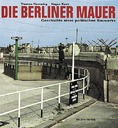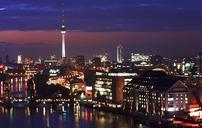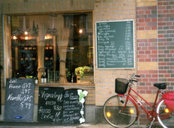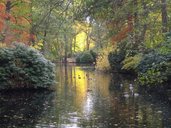
A series of surprises.
We enter an underground station: no ticket office, no ticket barriers, we walk onto the platform. There is a touch-screen machine for buying tickets, which takes coins and notes, and gives change. The options are at first bewildering, and while studying the screen, a man comes up and says: Kann ich ihnen helfen? (Can I help you?) He is smiling, and quickly does help us. It turns out that for £1.40 we can buy a ticket, valid for two hours, with which we can travel all over the city, by underground, surface railway, bus or train, changing as often we like. Amazing. But for £14 we can get a 72-hour ticket which we can use as often as we want. Could this work in London? There are ticket inspectors, but we never saw one. And at least another half-a-dozen times, seeing us poring over a map, someone comes up to us, and smilingly offers help.
Berlin has more parks, green spaces, squares and trees than London. It has many more wide streets than Paris. We never saw a traffic jam- indeed, the traffic seemed to move quickly. Many streets have two tram lines in the centre, two lanes for cars on either side, space for parked cars, and then wide pavements with trees. The trees being wide apart, the streets are light, open to the sky, and there is no smog. But there are some narrow streets too. In only one or two streets do big shops dominate- otherwise, it is a mix of flats, shops, restaurants and cafés, which feels human and congenial. Another feature is that there are many courtyards, sometimes leading one to another to another, presumably from the days of horses and carriages, and now with artists’ studios, boutiques of all kinds, more cafés, or just flats, small gardens, and children playing.
What about the war? What about the Nazi regime? There was much destruction from bombing, and bombardment during the final days of the war. Then came partition of the city, the west surrounded by a dreary, grey communist sea. Reunification found grey concrete blocs in the east but such undamaged buildings as survived, left intact. In the west, some horrific inhuman modern architecture replaced ruins and, in some cases, old buildings; but in other areas there has been much more sensitive rebuilding. For example, one house of a terrace left standing: the terrace is rebuilt around it, all houses of the same height and with the same size of windows, giving a certain feeling of unity and order to the street.
The number of museums is quite extraordinary- dozens and dozens. Museuminsel (Museum Island), with the river Spree on one side and a canal on the other, already houses several, and others are being rebuilt and extended. The major collections rival those of London and Paris- Egyptian and other antiquities, painting and sculpture of all periods, crafts from all over the world….
The population has greatly changed. After reunification, many left, especially from the eastern part of the city, to the west- they wanted to get away as far as possible from the former East Germany. But others came, especially when the capital was transferred back to Berlin, so there are few who knew it in Nazi days, and hardly any who were then grown up There are many young people now- it feels like a young people’s city.
I feel it would be an interesting place to live.
A wineshop and the Tiergarten
Footnote
At the exhibition Breaking the Rules (at the British Library until March 30th 2008) there is a film of Berlin in the 30s made by the futurist artist László Moholy-Nagy. As you enter the exhibition it is showing in the far right hand corner.



